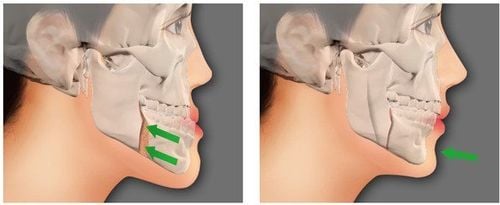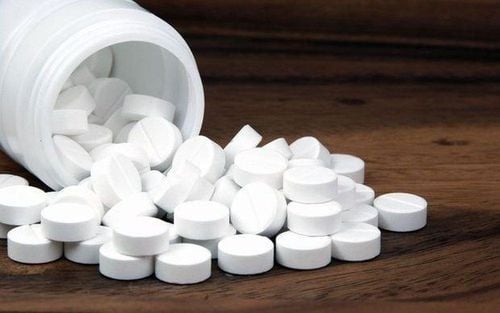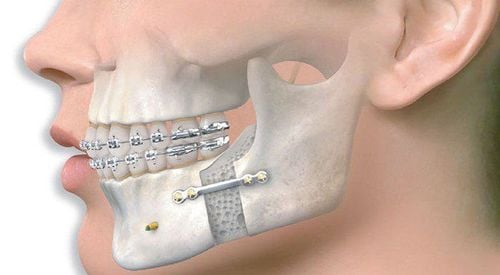This is an automatically translated article.
Posted by Master, Doctor Lai Do Quyen - Interdisciplinary Department - Vinmec Times City International Hospital.Tooth decay is a common disease that can affect people of all ages. There are many causes of tooth decay, such as: Bacteria, diet, poor oral hygiene, low saliva, etc. Tooth decay not only affects chewing function but also affects function. aesthetics of teeth.
1. What is tooth decay or filling?
Cavity filling is a technique that uses dental filling materials to fill the gaps and fill in the missing tooth tissue caused by tooth decay, returning the original shape and size to the tooth.2. Harm when tooth decay is not treated in time
Currently, deep filling is a common dental procedure because the technique is quite simple and painless. However, for many reasons, patients tend to delay or not have dental fillings right away. This can bring discomfort or complications as follows:The function of chewing is affected: Cavities make teeth sensitive, causing discomfort when chewing. On the other hand, tooth decay creates holes in the tooth surface, food is easily deposited in the deep hole, creating an unpleasant breath odor and compressing the gums, causing pain when chewing. Large caries that lose a lot of organization or only the roots of the teeth will not be strong enough to perform the chewing function. Risk of infection: Food that remains in the deep hole along with avoiding chewing on the side of sensitive teeth will easily create tartar and increase the risk of infection. With deep holes in the interdental spaces, food stuck under the gums causes pain, bleeding and increases the risk of interdental gingivitis. Tooth decay exposes the dentin organization, which is a favorable factor for bacteria to penetrate into the tooth pulp. Cavities can be broken due to the loss of many tooth tissues, causing open pulp. The affected tooth pulp will cause toothache, dead pulp, infected pulp and many local or diffuse infectious complications, affecting oral and systemic health.
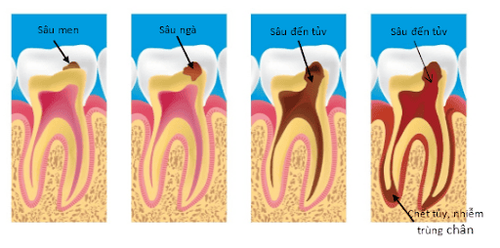
Sâu răng tiến triển đến nhiễm trùng tại chỗ
3. When should dental fillings?
Detecting tooth decay is not difficult, patients can detect it by themselves when they see a hole in the tooth surface, the tooth surface has a black discoloration. But sometimes just see the tooth sensitivity without seeing the cavity or feel nothing. At this time, the dentist will conduct a dental film to detect cavities that are invisible to the naked eye.Cavity filling should be carried out as soon as the cavity is discovered or done as soon as possible, should not be delayed for long.
4. Deep tooth filling process
4.1 Cavity fillings Cavity fillings are used to restore surface defects caused by caries. They will remain on the tooth surface and stay in the mouth for a long time, so the filling materials must be benign, withstand good chewing force, have little wear, do not cause irritation to the teeth and mouth, and are not harmful to the body. On the other hand, dental filling materials must be easy to manipulate in the mouth so that when performing dental fillings, it does not cause discomfort to you.Currently, there are many filling materials on the market. Here are some commonly used materials:
Composite fillings: This is the most widely used material for dental fillings today, especially cosmetic dental fillings. This type of material has a similar color to the tooth color, high wear resistance and strength. However, after welding, the teeth may be sensitive because the teeth are stimulated by the fillings and adhesives. After a few years, the solder can discolor, break, and need to be replaced. Glass cement (GIC cement): As a hydrophilic, fast acting material, it is used to seal teeth in difficult positions to isolate saliva and to seal children's teeth in case the child does not cooperate. Fluoride-releasing materials are substances that help organize teeth hard against tooth decay. However, this material is fragile, wears out quickly, has few colors to choose from, and does not create the desired tooth shape. Amalgam: A material used to seal teeth since a long time ago. This material is wear-resistant and high-strength. However, the material has a dark color like metal, which is not aesthetically pleasing, so it is often used to seal teeth located deep in the mouth. On the other hand, when using Amalgam fillings, the dentist must create pins to store the filling on the teeth, so the healthy tooth organization is lost a lot, the teeth are fragile. After a while, the dark color of the filling will seep into the teeth, making the teeth darker. In the past, Amalgam material was often used, but now this material is not used anymore because it contains mercury which is a harmful metal to the body. Metal: The metal used is a titanium or gold compound that has good compatibility with teeth and the oral environment. This material is wear-resistant and strong, so it is only used for molars. Because it is made at the dental workshop, the filling has a tight edge, especially the gold material, limiting tooth decay later on. However, the color is different from the tooth color, so it is not aesthetic. Techniques make it more complicated.
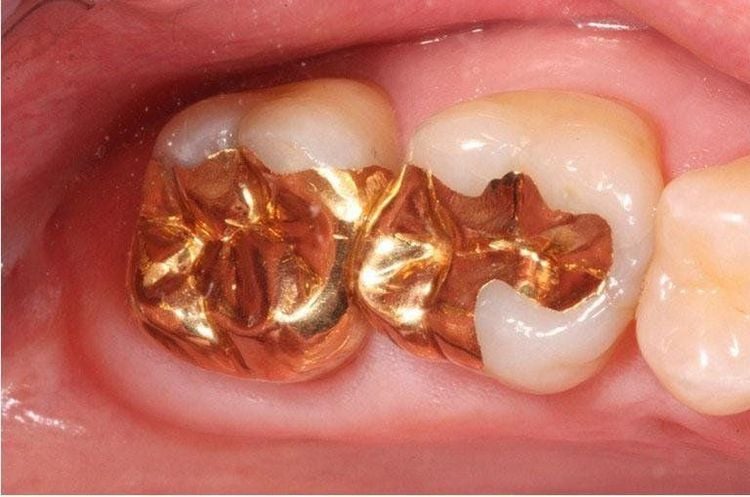
Vật liệu kim loại là vàng
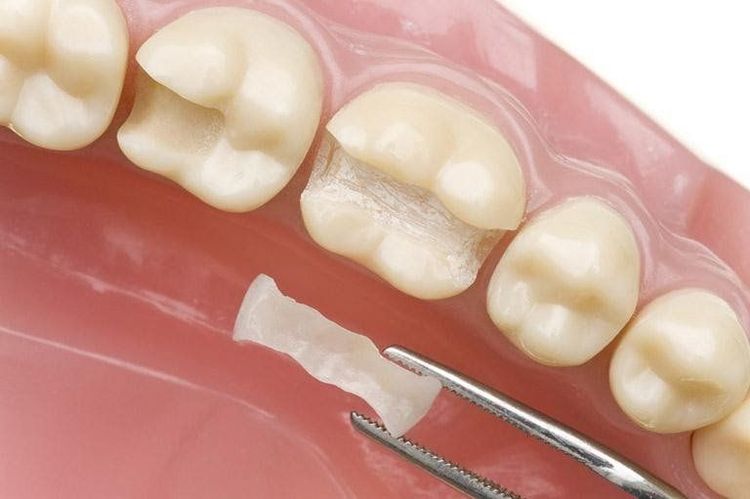
Vật liệu sứ
The dentist will determine the decayed tooth, the position of the cavity on the tooth surface by examination and by dental film. The dentist will also explain and agree with the patient about the filling material. Local anesthesia can be performed depending on the size and depth of the cavity to avoid discomfort when the filling steps are carried out. The local anesthetic will not cause discomfort because before injecting the anesthetic, the dentist will put a local anesthetic gel in the place where the needle will be inserted. Local anesthetic gel will help the patient not feel uncomfortable when the anesthetic is injected. Clean the sides of the tooth to be welded and the adjacent teeth to ensure the quality and aesthetics of the weld. Cleaning the deep hole: The dentist will use a tool to remove all the food stuck in the deep hole, remove all the deep dentin organization to avoid maximum tooth decay after filling. Shaping a deep hole to ensure good adhesion of the sealant on the tooth surface. Placing a bottom liner: Depending on the depth and width of the wormhole, your dentist will place a smooth cement layer at the bottom of the crevice. This layer of cement has the effect of protecting the tooth pulp below, preventing teeth from being sensitive after filling. Filling: Dental filling is placed into the cavity to fill the cavity. Editing; When the filling is hard, the dentist will use tools to correct and remove excess solder to recreate the shape and size of the tooth, ensuring high aesthetics.
5. Notes after filling deep teeth
Before leaving the dental clinic, the patient will be advised by the dentist about the discomforts that may be encountered after the filling, the notes after the filling, the way to chew and the oral hygiene at the place of the filling. . Specifically as follows:There will be some discomfort caused by the effect of the anesthetic such as: Feeling that the patient's face is swollen, numb, feeling your lips, cheeks, and even your eyes are drooping. These discomforts should go away as soon as the anesthetic wears off. After dental filling, do not chew to the side that is numb to avoid biting or chewing on the lips and cheeks because there is no feeling, should not eat or drink too hot to avoid burns while the anesthetic is still available. It is necessary to know the time to eat and chew with the newly welded teeth to avoid peeling and wearing the solder. With Composite welding, the patient can eat and chew immediately, but with other fillings, it is recommended to avoid chewing to the side with the solder for about 4 hours. Avoid foods that are too hot, too cold, or too hard for the first few days so that the tooth doesn't become irritated and cause sensitivity or pain. Using a toothpick or hard object to floss in places where there is a filling in between the teeth will cause the solder to peel and break. Ideally, floss should be used to clean between the teeth according to the instructions of the dentist. The brushing should be gentle to avoid hurting, scratching the gums, avoiding tooth wear and avoiding peeling and wearing of fillings. Limit the use of colored foods, drinks, coffee, cigarettes, etc. to avoid tarnishing the solder. Today, dental fillings are quite simple, painless and good filling materials are no longer a problem for patients to worry about. Take the initiative to have regular dental check-ups every 6 months to always have a confident, shining smile.
To register for examination and treatment at Vinmec International General Hospital, you can contact Vinmec Health System nationwide, or register online HERE.
SEE MORE
Molar tooth decay in children: Easy to catch, difficult to treat Tooth decay in children: Causes, early signs of early recognition Why are teeth sensitive?






